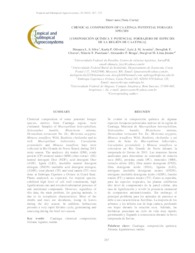Chemical composition of caatinga potential forages species.
Chemical composition of caatinga potential forages species.
Author(s): SILVA, D. L. S.; OLIVEIRA, K. P.; AROEIRA, L. J. M.; CHAVES, D. F.; PONCIANO, M. F.; BRAGA, A. P.; LIMA JUNIOR, D. M.
Summary: Abstract: Chemical composition of some potential forages species, natives from Caatinga region, were evaluated. Samples of Macroptilium heterophyllum, Stylosanthes humilis, Rhynchosia mÃnima, Desmodium tortuosum Sw. Dc, Merremia aegyptia, Mimosa tenuiflora Wild, Bauhinia cheilantha and as well Macroptilium lathyroides, Caesalpinia pyramidalis and Mimosa tenuiflora hays were collected in Rio Grande do Norte Stated, during 2011 rainy season. The analyses: dry matter (DM), crude protein (CP) mineral matter (MM) ether extract (EE) neutral detergent fiber (NDF), acid detergent fiber (ADF), lignin (LIG), insoluble neutral detergent nitrogen, (INDN) insoluble acid detergent nitrogen, (ADIN), total phenol (TF) and total tannin (TT) were done at Embrapa Caprinos e Ovinos in Ceará State. Plants analyzed, as expected, for tropical species, exhibited high level of cell wall constituents, high lignifications rate and revealed substantial presence of anti nutritional compounds. However, regardless of this data, the main problem, for grazing animals, is due to its xerophytes characteristics. Most of the shrubs and trees are deciduous, losing its leaves during the dry season. In addition, herbaceous presents a very rapid lifetime cycle, germinating and senescing during the brief wet season. [Composición química y potencial forrajero de especies de la región de Caatinga]. Resumen: Se evaluó la composición química de algunas especies forrajeras potenciales nativas de la región de Caatinga. Muestras de Macroptilium heterophyllum, Stylosanthes humilis, Rhynchosia minima, Desmodium tortuosum Sw. Dc, Merremia aegyptia, Mimosa tenuiflora Wild, Bauhinia cheilantha y así como de heno de Macroptilium lathyroides, Caesalpinia pyramidalis y Mimosa tenuiflora se colectaron en Rio Grande do Norte durante la temporada de lluvias de 2011. Las muestras fueron analizadas para determinar su contenido de materia seca (MS), proteína cruda (PC), minerales (MM), extracto etéreo (EE), fibra neutro detergente (FND), fibra detergente ácido (FDA), lignina (LIG), nitrógeno insoluble detergente neutro (INDN), nitrógeno insoluble detergente ácido (ADIN), fenoles totales (FT) y taninos totales (TT). Como se esperaba, para las especies tropicales, las plantas exhibieron alto nivel de componentes de la pared celular, alta tasa de lignificación y reveló la presencia sustancial de compuestos antinutricionales. Sin embargo, el principal problema para los animales de pastoreo se debe a sus características Xerófitas. La mayoría de los arbustos y los árboles son de hoja caduca, perdiendo sus hojas durante la estación seca. Además, las herbáceas presentan un ciclo de vida muy rápido, germinando y llegando a senescencia durante la breve temporada de lluvias
Publication year: 2015
Types of publication: Journal article
Unit: Embrapa Goats & Sheep
Keywords: Bauhinia cheilantha, Caatinga, Caesalpinia Pyramidalis, Catingueira, Chemical composition, Composição Química, Desmodium tortuosum, Espécie Nativa, Forage legumes, Jitirana, Jurema Preta, Leguminosa Forrageira, Macroptilium heterophyllum, Macroptilium lathyroides, Merremia aegyptia, Mimosa tenuiflora, Rhynchosia mínima, Semiarid zones, Stylosanthes Humilis, Tanino, Tannins, Vegetation, Vegetação Nativa
Observation
Some of Embrapa's publications are published as ePub files. To read them, use or download one of the following free software options to your computer or mobile device. Android: Google Play Books; IOS: iBooks; Windows and Linux: Calibre.
Access other publications
Access the Agricultural Research Database (BDPA) to consult Embrapa's full library collection and records.
Visit Embrapa Bookstore to purchase books and other publications sold by Embrapa.

